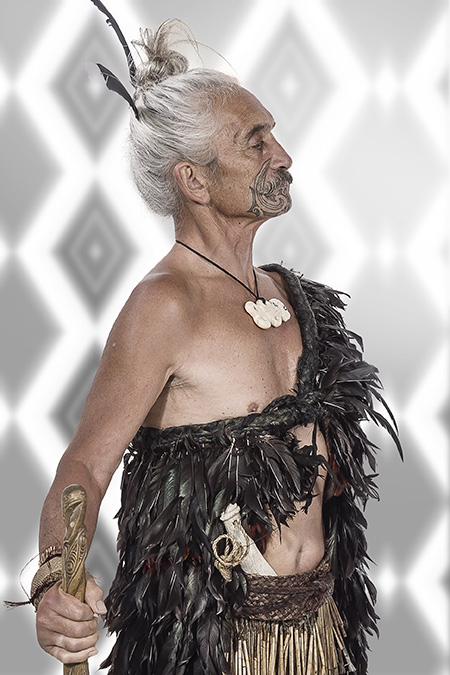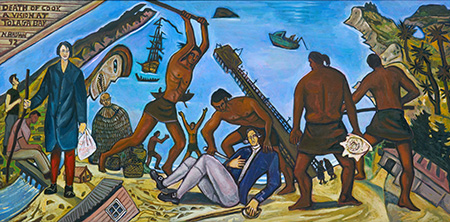Tranquillity Disturb’d: A contemporary look at historical New Zealand
review by Philippa Steel
‘The portrait artist is an alchemist who seeks to make inert physical material “live” and show us a person’, argues Cynthia Freeland in her book Portraits and Person: A Philosophical Inquiry (2010). Three stylistically diverse artists – Nigel Brown, Gavin Hurley and Lisa Reihana – have risen to this challenge in the New Zealand Portrait Gallery’s current exhibition, Tranquillity Disturb’d: A Contemporary Look at Historical New Zealand, on display until 31 May 2015. Captain James Cook’s voyages have always been a subject of fascination for artists, historians and writers alike. In this exhibition, each artist has responded to this history in markedly different ways, and the exhibition’s curator, Richard Wolfe, has assisted them in this quest. Wolfe explored the notion of ‘the Portrait’ in his book New Zealand Portraits (2008), and now he takes the opportunity to go beyond the traditional viewpoint that portraits should be drawn or painted based on observation from real life. In Tranquillity Disturb’d he has curated an exhibition where images from all three artists ‘spring from the mind’. His stated intentions for this show are ‘to both demonstrate the diversity of contemporary portraiture and to provide an alternative perspective to accepted versions of history’. Acknowledging these parameters, each artist has a personal take on bringing history to life. Together they offer varied thematic and artistic interpretations of Cook’s discovery and exploration of the Pacific, and the subsequent (and sometimes contentious) impact of European contact.
Portraiture is complex and, by its nature, in an exhibition setting, it initiates a two-way relationship between the artwork being viewed and the viewers themselves. This exhibition has been cleverly designed to integrate the different groupings of artist-selected artworks intermingled throughout the exhibition to produce the element of diversity and surprise as the viewer moves through the gallery. Works by each artist are effectively juxtaposed against each other because of their placement, emphasising both stylistic differences and the connections and the contrasts of the ideas explored.
Central to the show and reflecting the era it was inspired by is the prominent ‘Cabinet of curiosities’, displaying the artists’ ephemera of sketches, collages, research materials, photographs and carvings. These offer an inkling of the origins of the creative process and add another layer of meaning to the exhibition.
Lisa Reihana approaches this exhibition with the viewpoint of a Maori female artist, combining traditional portraiture and modern digital technology. Her narrative is explored in 12 large colour laser‑prints, taken from a video installation Pursuit of Venus, which was inspired by a 19th-century idealised wallpaper ‘Les sauvages de la Mer Pacifique’. Reihana has created these portraits from video footage of staged vignettes, using carefully selected actors in period costume. Convincing new personas, subtly referencing Captain Cook and others associated with him, stimulate contemporary dialogue on the implications of Cook’s arrival and the encounters between Europeans and tangata whenua, the Indigenous Maori people linked physically and spiritually to the land. The prints’ impact are heightened by the detail, scale and clarity of the images, but most effectively by Reihana’s placement of the portraits on contemporary digitally developed backgrounds, referencing traditional tukutuku panels (traditional Maori latticework used to decorate the interior of meeting houses). This reinterpretation of history is further accentuated by the placement of the striking portraits and their interconnections. Unexpectedly, the viewer can observe two Captain Cook portraits positioned side-by-side – one modelled by a male and the other by a female. This restaging provokes reconsideration of the consequences of European exploration and colonisation in the region.

colour laser print
New Zealand Portrait Gallery
Gavin Hurley takes a different perspective by bringing to life the Endeavour’s servant boys who, with the exception of ‘Young Nic’, have remained anonymous in history. Inspired by formal, traditional schoolboy portraits, Hurley exhibits a distinctive series in oils where the boys’ imagined faces are based on the modern idea of an ‘identikit’. The youthful visages confront the viewer with an uncomfortable range of emotions from all walls of the gallery, crying out for attention after all these years.

paper collage
New Zealand Portrait Gallery
Unnervingly, the artist uses the same simplified face for his portraits, varying only the size, hair and eye colour, and utilising distinctive, meaningful accessories. However, despite the uniformity of their stylised features and the artist’s application of flat, smoothly modelled paint, each boy’s personality shows through. The viewer ponders the hardships these boys must have faced and it is poignant that two smaller, first-worked paper collages distinctly portray the two who died in South America during the voyage.
The perspectives taken by Nigel Brown are complex as he has been exploring themes related to Captain Cook and the Pacific in his work since the 1990s. This exhibition includes Brown’s early works alongside recent interpretations, and this wide-ranging timespan reveals varied compositions and artistic concerns. Brown’s distinctive style, worked in the media of oils and acrylic, layers the obvious influences of Indigenous cultures, romanticism and expressionism alongside ‘homegrown’ iconographies. There are times when his multifaceted portraits uncomfortably challenge the viewer. As cultural historian Robert Lumley has observed, the portrait artist ‘plays on the public’s fascination with the private lives of great men, simultaneously provoking awe and deconsecrating the act of worship’, as we are forced to consider aspects of Cook anew. Within this body of work, the distinct thematic groupings of artists, explorers and poets also appear and, although Brown’s subjects sometimes extend well beyond connections to Cook, the curator’s intentions have been fulfilled. Brown secures the historical threads of this exhibition for the viewer with the prominent The Nature of Freedom, a work that explores the concepts of artistic, social and political freedom through the linking of imagery with poetry. He offers a powerful postcolonial conclusion while simultaneously layering complexity on the already lively artistic and political debate.

oil on board
New Zealand Portrait Gallery
The question has frequently been posed about how artists can ever succeed in conveying truths about subjects in portraiture. In Tranquillity Disturb’d, Reihana, Hurley and Brown have succeeded in achieving multiple realities with their interpretations and reawakenings of figures from Pacific history. In doing so they have moved beyond the ‘truths’ of physical appearances into historical commentary confronting an uncomfortable past from different standpoints. Their ‘alchemy’ portrays an eclectic range of convincing individuals within the themes of (re)discovery and colonisation, challenging the viewer with a complex range of political, aesthetic, psychological and emotional questions to ponder and grapple with long after leaving this exhibition.
Philippa Steel is currently a student undertaking the Museum and Heritage Studies programme at Victoria University of Wellington, New Zealand. She is a teacher of Visual Art and Art History.
| Exhibition: | Tranquillity Disturb’d: A contemporary look at historical New Zealand |
| Institution: | New Zealand Portrait Gallery |
| Entry fee: |
Free |
| Curator: | Richard Wolfe |
| Artists: | Nigel Brown, Gavin Hurley, Lisa Reihana |
| Dates: |
12 March to 31 May 2015 |
| Exhibition website: | Tranquillity Disturb’d: A contemporary look at historical New Zealand |
